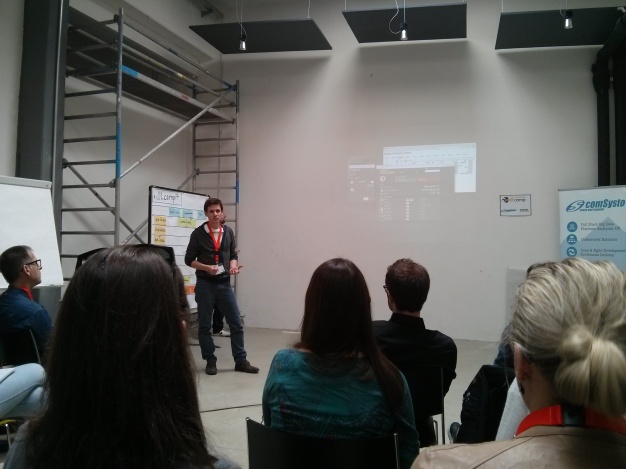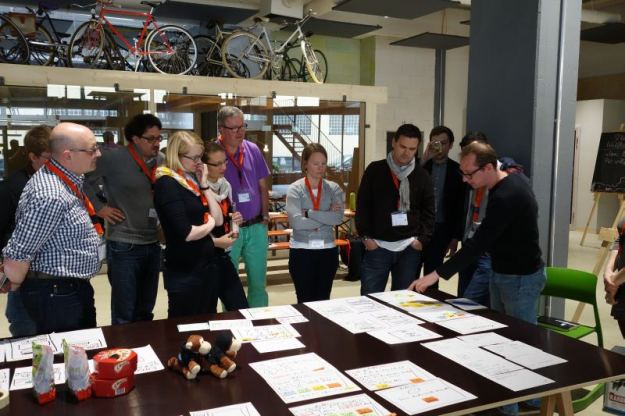When we found out that dtcamp #14 was planned to take place in Munich, comSysto’s design enthusiasts could not resist to support the camp. Dtcamp is a bar camp, targeting design thinking, UX Design, and other related topics. A bar camp is an open conference, organized by and for its participants. So each morning planned or spontaneous sessions were presented, voted on, and scheduled for the day. Since attending a bar camp is free for all attendants, a camp needs sponsors. So we took the opportunity to sponsor the camp because design thinking is an awesome method to shape the world of tomorrow.
On the first day, Dr. Stephan Raimer held the introduction session and opened up with explaining the basics of bar camps. The sponsors had the possibility to present themselves. We decided to present one of our upcoming products: Teamgeist.io. With Teamgeist.io we want to change the way teams interact with each other. We strongly believe that working in teams will be very different in the future. We already experience a trend towards agile and highly distributed teams which work in a self-organized way. Traditional team management software often does not fit into this context. That’s why we build Teamgeist.io, to support teams to take on the challenge of collaboration, planning, and communication.

Afterwards the sessions for the day were presented. Over both days the participants offered great sessions with very different contexts. The sessions that caught our interest most were:
‘Scrum + Rapid Prototyping = Erlebtes Scrum – Wie Du Scrum mit Hilfe einer echten Produktidee erlernst’
Knowing a method like scrum is good, being able to work with it is even better. Martin Geckexplained how he uses the FabLab environment to teach Scrum with a hands on hardware project. Experiencing Scrum with a sample project definitively eases the learning process -and could it be any better if you are allowed to use cool 3D printing technology?
‘New Management – Führen mit Design Thinking’
Based on Angela Haas‘s experience of Design Thinking in management with her company ‘partake’, we discussed important points of good leadership and possible methods to achieve them. Especially, her initial ice breaker was great fun (more can be found with the Warm-up Shuffle App).
‘Improvisationstheater, Innovation und Design Thinking’
One of the most active sessions we visited was Dr. Christian Lang‘s impro session. The participants experienced basic improvisation games and learned how those exercises can foster brainstorming sessions, innovation and Design Thinking.
‘Visual Prototyping Toolkit: Wieso? Weshalb? Warum?’
In this session Harriet Kasper and Anne Elisabeth Krüger from Frauenhofer kreativ presented their visual prototyping toolkit. We developed new ways of talent search hands on via social media and visualized them using the toolkit. The enormous outcome was presented afterwards and together we discussed further improvements of the kit.
Apart from participating in sessions we also offered three sessions ourselves. All sessions derived directly from our day to day work experiences and focussed on sharing our discoveries and best practices with the participants.
Session 1 – How to do UX research with a limited budget
UX research is a topic that is often discussed. Most people see value in it and yet in many cases the advantages of UX research are not used because there are underlying fears of costs and time investments.

With this session we wanted to give advice to those who are interested in applying UX research methods in upcoming projects by answering basic questions on how to prepare a usability test, how to recruit participants, and on how to evaluate the test session to gain insights. This topic has been near and dear to our hearts for a while and we provided a talk about this topic in fall 2013 at w-jax13. If you’re interested in that topic, we have a video recording of a similar talk held at Java Lightweight User Group Munich on our YouTube channel.
Session 2 – Hands on UX research. How to write a usability test script?
On day two we held a very practical session on how to write a usability test script. The main focus was on how convert assumptions into tasks and how to write the corresponding text for the test script. We used Teamgeist.io as an example and the session participants came up with good task examples. At the session’s end we showed a short clip from previous usability tests to demonstrate what kind of insights can be gained from usability testing.
Session 3 – Instant Paper Prototyping Game
Normally, paper prototypes are first designed and then tested with users. In this session, we tried to design paper prototypes instantly driven by the user’s expectations. Therefore, the participants grouped in pairs with one person acting as ‘User’ and one as ‘Instant UI Designer’. After each interaction, the user was asked what they were expecting to happen and the next frame was drawn based on the answer.

At the end, all pairs presented their evolved prototypes and all participants voted for the best solutions. Finally, the best three teams received prizes and we discussed pros and cons of the method as well as possible fields of use.

To sum it up the dtcamp #14 was great fun, an awesome place to meet interesting people, and to broaden one’s view on design thinking and User Experience. We like to thank Dr. Stephan Raimer from oose Innovative Informatik for organizing the camp and Joscha Lautner, Johann Schorr, and Caspar Siebel from Impact Hub Munich for providing a very inspiring location.
If you want to learn more about our experiences and what comSysto can offer to you and your company in terms of UX, please contact Christina.Eckleder@comsysto.com!